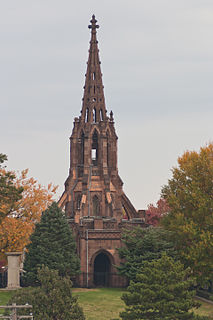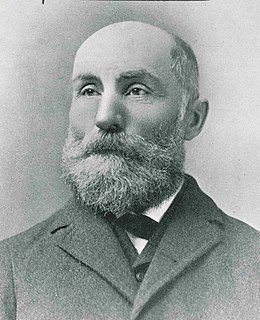Related Research Articles

Towson is an unincorporated community and a census-designated place in Baltimore County, Maryland, United States. The population was 55,197 as of the 2010 census. It is the county seat of Baltimore County and the second-most populous unincorporated county seat in the United States.
The African Union First Colored Methodist Protestant Church and Connection, usually called "the A.U.M.P. Church," is a Methodist denomination. It was chartered by Peter Spencer (1782–1843) in Wilmington, Delaware, in 1813 as the "Union Church of Africans," where it became known as the "African Union Church".

John Rudolph Niernsee was an American architect. He served as the head architect for the Baltimore and Ohio Railroad. Rudolph also largely contributed to the design and construction of the South Carolina State House located in Columbia, South Carolina. Along with his partner, James Crawford Neilson, Rudolph established the standard for professional design and construction of public works projects within Baltimore and across different states in the United States.
Edward Livingston Palmer Jr. was an American architect from Baltimore, Maryland, credited with the design and development of several planned neighborhoods such as Homeland, Roland Park, Guilford, Wawaset Park, and the design of many buildings within Dundalk, Maryland, which were created specifically for the workers of Bethlehem Steel

The Church of the Epiphany, built in 1844, is an historic Episcopal church located at 1317 G Street, N.W., in Washington, D.C. It was added to the National Register of Historic Places on September 10, 1971.

Towson United Methodist Church is a large United Methodist Church in the historic Hampton subdivision of Towson, a suburb in Baltimore County, Maryland. Its past, rooted in 19th-century America and subsequent growth in the two centuries since then, has closely paralleled the nation's political and sociological trends. It was a congregation split asunder in 1861 on the eve of the American Civil War in a border state of divided loyalties, which eventually reunited and built a church in the post–World War II era of the 1950s, a time of reconciliation and rapid growth by mainline Protestant denominations, especially in the more affluent suburbs.

Thomas Kelso (1784–1878) was an Irish-American philanthropist and businessman, who was born in Clones, a market town in the north of Ireland, August 28, 1784. He died on the morning of July 26, 1878 at his home of many years on East Baltimore Street in Baltimore, Maryland, at the age of 94.

The Kelso Home for Girls, formerly the Kelso Home and Orphan Asylum in Baltimore, Maryland, was a 19th-century orphanage and school building for girls on East Baltimore Street in the Jonestown/Old Town neighborhood, east of the Jones Falls. It was founded by businessman and philanthropist Thomas Kelso, (1784–1878), a former member of the old Methodist Episcopal Church, and inaugurated in January 1874. Formerly the Towson Family YMCA, it is now the Y of Central Maryland Towson Family Center.
Otto Eugene Adams (Sr.), the architect, was born in Baltimore, Maryland, on November 1, 1889, to a family with Baltimore and German ancestry.

Edmund George Lind was an English-born American architect, active in Baltimore, Atlanta, and the American south.

St. Mary's Episcopal Church, also known as the Church of St. Mary the Virgin, is an historic rectangular-shaped Carpenter Gothic style Episcopal church located at 5610 Dogwood Road in Woodlawn, Baltimore County, Maryland. Designed by the Baltimore architectural firm of Dixon and Carson, it was built in 1873. Its steeply pitched gable roof, board and batten siding, lancet windows and arched side entry way are all typical features of Carpenter Gothic churches.

Lovely Lane United Methodist Church, formerly known as First Methodist Episcopal Church, and earlier founded as Lovely Lane Chapel is a historic United Methodist church located at Baltimore, Maryland, United States.

James Crawford Neilson, or J. Crawford Neilson, was a Baltimore, Maryland-based architect. He was born in Baltimore, Maryland in 1816. After the death of his father in 1822 the family moved to England and in 1824 to Brussels. In 1833, he returned to Baltimore and in 1835, became a member of the survey party working on the Baltimore and Port Deposit Railroad,. His supervisor was Benjamin Henry Latrobe, II, (1806-1878), later supervising engineer on the Baltimore and Ohio Railroad,, son of an equally famous architect, Benjamin Henry Latrobe, (1764-1820). It was at this time that he first became acquainted with John Rudolph Niernsee, (1814-1885), while helping to survey in the area of Martinsburg, Virginia, for the Baltimore and Ohio Railroad.

Henry F. Brauns was an architect based in Baltimore, Maryland, USA. He was a son of Ferdinand L. and Henrietta Brauns and was one of ten brothers and sisters. His grandfather C.W. Brauns had fought during the Revolutionary War in a Hessian regiment. Among his brothers were Rev. F.W. Brauns a Presbyterian minister, Ferdinand L. Brauns an accountant of local repute. Brauns came from the German Brauns family from Lower Saxony and was also a descendant of Benjamin Edes and Peter Tufts. He started his practice at the age of 18. He was a charter member of the Baltimore Chapter of the Archaeological Institute of America in December 1870.
Charles L. Carson, was an architect born in Baltimore, the oldest son of Daniel Carson, a builder, and one of the founders of the Baltimore chapter of AIA. Carson had little formal training as an architect. Around 1870 he partnered with Thomas Dixon (architect) while taking drawing lessons at the Maryland Institute College of Art. Carson and Dixon worked from their offices at 117 Baltimore Street as Thomas Dixon and Charles L. Carson until sometime before 1877 when the partnership was dissolved. In 1888 he hired Joseph Evans Sperry who became his chief assistant, and later his partner and successor.
Asbury United Methodist Church or Asbury Methodist Episcopal Church, or variations on Asbury Methodist Church, may refer to:
John Hudson Riddick was an educator, community leader, and minister in the African Methodist Episcopal (AME) church. In 1872 he was elected a member of the Norfolk, Virginia city council. He was an AME minister at a number of churches and a leader in the Washington and Delaware Conferences of the church.

Grafton Marsh Bosley was a physician, philanthropist, planner, and politician. He was the son of Amon Bosley and Rebecca Marsh Bosley. He attended Dickinson College and University of Maryland Medical School. He married Margaretta M. Nicholson on May 5, 1857, and they had a single son, Arthur L. Bosley, before his wife's death in 1885.
Susie Estella Palmer Hamilton (1862-1942) was a suffragist and activist in Wilmington, Delaware, and a founding member of the Equal Suffrage Study Club.
References
- ↑ The Late Thomas Dixon, The Sun (1837-1985); Jul 27, 1886; ProQuest Historical Newspapers The Baltimore Sun (1837-1985) pg. 4
- ↑ American Institute of Architects and Engineers, The Sun (1837-1985); Nov 15, 1875; ProQuest Historical Newspapers The Baltimore Sun (1837-1985)
- ↑ Wollon, James T. (March 11, 2010). "Thomas Dixon". Baltimore Architecture Foundation.
- ↑ Changes In Business Firms, The Sun (1837-1985); Jan 3, 1871; ProQuest Historical Newspapers The Baltimore Sun (1837-1985) pg. 4
- ↑ The Obituary Record: Charles L. Carson The Well Known Architect, The Sun (1837-1985); Dec 19, 1891; ProQuest Historical Newspapers The Baltimore Sun (1837-1985) pg. 8
- ↑ Death Of Mrs. R.H. Dixon, The Sun (1837-1985); Apr 28, 1898; ProQuest Historical Newspapers "The Baltimore Sun" (1837-1985) pg. 8
- ↑ Died, The Sun (1837-1985); Jul 27, 1886; ProQuest Historical Newspapers The Baltimore Sun (1837-1985) pg. 2
- 1 2 "National Register Information System". National Register of Historic Places . National Park Service. April 15, 2008.
- ↑ The Architecture of Baltimore an Illustrated History, Hayward & Shivers, 2004 ISBN 0-8018-7806-3, p. 142
- ↑ Baltimore County Panorama, Brooks & Parsons, ISBN 0-937076-03-1, p. 29